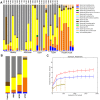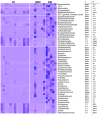Diversified microbiota of meconium is affected by maternal diabetes status
- PMID: 24223144
- PMCID: PMC3819383
- DOI: 10.1371/journal.pone.0078257
Diversified microbiota of meconium is affected by maternal diabetes status
Abstract
Objectives: This study was aimed to assess the diversity of the meconium microbiome and determine if the bacterial community is affected by maternal diabetes status.
Methods: The first intestinal discharge (meconium) was collected from 23 newborns stratified by maternal diabetes status: 4 mothers had pre-gestational type 2 diabetes mellitus (DM) including one mother with dizygotic twins, 5 developed gestational diabetes mellitus (GDM) and 13 had no diabetes. The meconium microbiome was profiled using multi-barcode 16S rRNA sequencing followed by taxonomic assignment and diversity analysis.
Results: All meconium samples were not sterile and contained diversified microbiota. Compared with adult feces, the meconium showed a lower species diversity, higher sample-to-sample variation, and enrichment of Proteobacteria and reduction of Bacteroidetes. Among the meconium samples, the taxonomy analyses suggested that the overall bacterial content significantly differed by maternal diabetes status, with the microbiome of the DM group showing higher alpha-diversity than that of no-diabetes or GDM groups. No global difference was found between babies delivered vaginally versus via Cesarean-section. Regression analysis showed that the most robust predictor for the meconium microbiota composition was the maternal diabetes status that preceded pregnancy. Specifically, Bacteroidetes (phyla) and Parabacteriodes (genus) were enriched in the meconium in the DM group compared to the no-diabetes group.
Conclusions: Our study provides evidence that meconium contains diversified microbiota and is not affected by the mode of delivery. It also suggests that the meconium microbiome of infants born to mothers with DM is enriched for the same bacterial taxa as those reported in the fecal microbiome of adult DM patients.
Conflict of interest statement
Figures




References
-
- Barker DJ (2004) The developmental origins of adult disease. J Am Coll Nutr 23: 588S–595S. - PubMed
-
- Buchanan TA (1995) Pregnancy in preexisting diabetes. National Diabetes Data Group: Diabetes in America. pp. 719–733.
-
- Dunne F, Brydon P, Smith K, Gee H (2003) Pregnancy in women with Type 2 diabetes: 12 years outcome data 1990–2002. Diabet Med 20: 734–738. - PubMed
-
- Bell R, Glinianaia SV, Tennant PW, Bilous RW, Rankin J (2012) Peri-conception hyperglycaemia and nephropathy are associated with risk of congenital anomaly in women with pre-existing diabetes: a population-based cohort study. Diabetologia - PubMed
Publication types
MeSH terms
Substances
Grants and funding
LinkOut - more resources
Full Text Sources
Other Literature Sources

